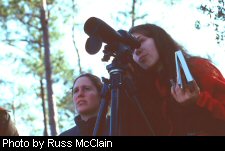

|
Coming Through: WV's Path For Migration By Russ McClain Coming from as far away as South America, these new arrivals are often in stark contrast to the late winter grayness of Appalachia, sporting uniforms of bright red, indigo blue and vibrant yellows. From the jumbled, rattled whistles of the yellow-breasted chat to the melodic, liquid tune of the wood thrush, the fact that a new season is upon us cannot be ignored. Neotropical migrant birds are those that, for the most part, nest in North America but spend the winter months as far south as the tropical habitats of Mexico, the Caribbean, and Central and South America. Over half of the 171 species of breeding birds typically seen or heard in West Virginia during the summer are neotropical migrants. Indeed, almost half of all bird species that breed in the United States and Canada migrate to the neotropics where they spend six to nine months before returning north in the spring. Most of them are insectivores, catching insects in a variety of entertaining ways-- mid-air fly catching, flushing prey from the ground and diving into old leaf tangles in the forest canopy. In the spring, it is the increased food abundance, and the reduced competition for other resources such as nesting space, that brings them north. Examples of West Virginia neotropical migrants include the broad-winged hawk, yellow-billed cuckoo, red-eyed vireo, cerulean warbler, scarlet tanager and the rose-breasted grosbeak which is featured on our state's Wildlife license plate. The remainder of our breeding birds are either considered residents, spending the entire year close to the breeding grounds, or short-distance temperate migrants, wintering north of the tropics in places such as the southern United States. Familiar birds such as the pileated woodpecker, northern cardinal, blue jay, chickadee and tufted titmouse generally stay with us from summer into the winter, often visiting our backyard feeders, eating wild seed, or gathering dormant insects from the bark of trees. Other species, such as the American robin, cedar waxwing, red-tailed hawk, eastern bluebird and American goldfinch, while seemingly present year-round, often
will migrate short distances to escape colder temperatures and harsh conditions. The individuals of these species seen in the summer may be an entirely different set of birds than seen in the winter. For instance, the goldfinch you see at your thistle feeder in January may be on winter vacation from Pennsylvania! As early as the end of February in some counties, our resident comradery of chickadees, titmice, cardinals, finches and woodpeckers is complemented by an influx of temperate and tropical migrant birds. One of the earliest arrivals, the eastern phoebe, can be found calling out in open spaces, advertising for a mate before most flowers have broken the ground. In fact, most pairs of eastern phoebes complete their first nest prior to the arrival of many other migrant songbirds. Another species, the tree swallow, also arrives around this time, sustaining itself on berries and seeds until the weather warms. Many other early migrants also eat fruit in the beginning of the breeding season, because insects are less available during the transition to spring. These early arrivals are not typical of most of our neotropical migrants however. Typically, most neotropical migrant birds arrive in West Virginia from early April to late May. The peak of migration occurs during the last two weeks of April and the first two weeks of May. During this time, multitudes of neotropical birds descend on the state, including many warblers, vireos, swallows, flycatchers and thrush species. The Louisiana waterthrush is usually the earliest warbler to appear in the state, setting up residence along wooded stream bottoms where it feeds upon early-emerging aquatic insects such as mayflies and dragonflies, and the occasional crayfish. The yellow-throated warbler is also an early arrival, primarily being spotted in areas of lower elevation such as the New River Gorge and Ohio River Valley. They most often settle in areas of mature bottomland forest, in sycamore groves and open woodlands. In the higher elevations of the Allegheny mountains, the blue-headed vireo is one of the first breeders present on the nesting grounds while many other migrants are still moving through the state. With its quizzical calls, it is a birdwatching favorite as it searches diligently for insects along branches and twigs--occasionally snatching them from mid-air! As many a West Virginia birdwatcher can attest, our state is truly an exceptional area in which to see numerous neotropical migrant By traveling a short distance within the state, you can see both northern species, such as the Canada warbler, and southern species, such as the summer tanager. Our large tracts of mature, unbroken forest, as well as the variety of wetland and high elevation habitats, present an apparent endless variety of places to explore and enjoy watching birds, whether it be the return of a favorite species or the discovery of one you've never seen. Russ McClain , a former ornithologist with the DNR and coordinator of the WV PIF working group, is stationed in Elkins .
|
 One of the most conspicuous and eagerly awaited signs of spring in the Mountain State is the return of our neotropical migrant songbirds. Whether enjoying a morning spent hunting for spring gobblers or simply taking a hike in one of the state's many natural areas, the activity and sounds of our returning songbirds are hard to miss.
One of the most conspicuous and eagerly awaited signs of spring in the Mountain State is the return of our neotropical migrant songbirds. Whether enjoying a morning spent hunting for spring gobblers or simply taking a hike in one of the state's many natural areas, the activity and sounds of our returning songbirds are hard to miss.  birds, both during migration and the nesting season. Varying greatly in latitude, longitude and elevation, the Mountain State provides wonderful opportunities to view a variety of nesting birds.
birds, both during migration and the nesting season. Varying greatly in latitude, longitude and elevation, the Mountain State provides wonderful opportunities to view a variety of nesting birds.